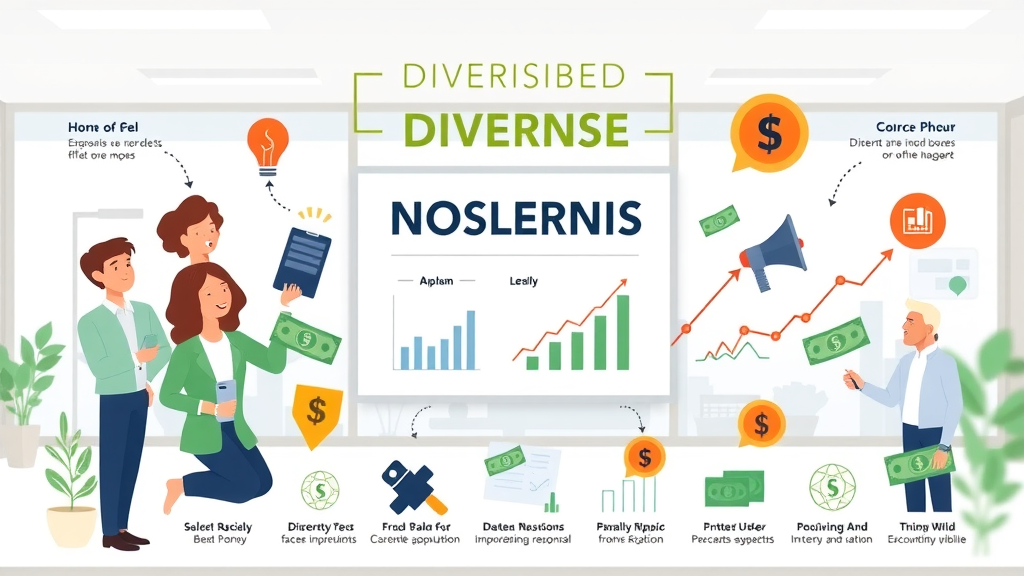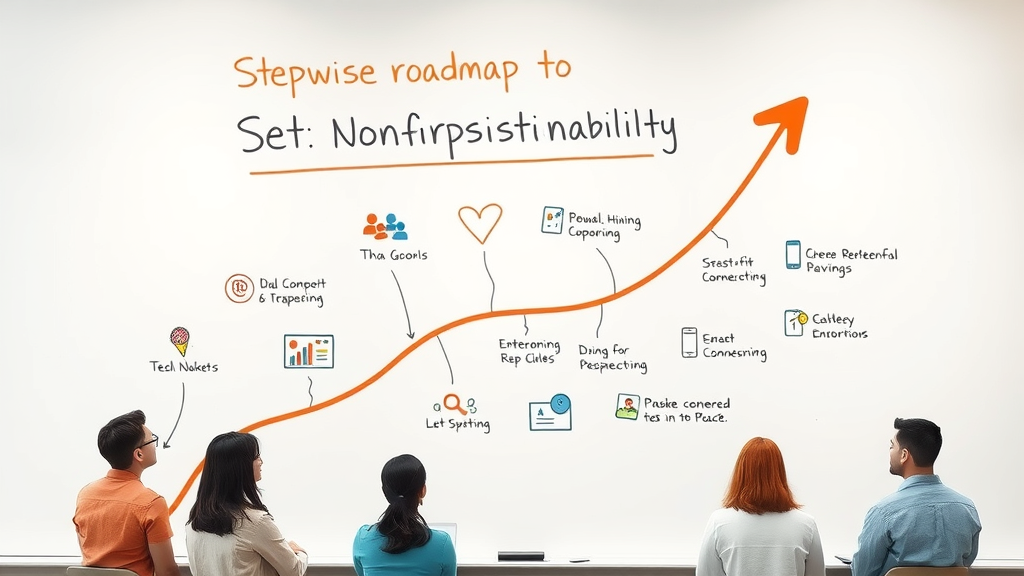Did you know? More than 50% of nonprofit organizations fail to survive past five years—lack of sustainability in nonprofits is one of the leading causes. In an ever-evolving world, where social needs continue to grow and donor behavior shifts rapidly, sustainability in nonprofits isn’t just a buzzword—it’s the foundation for achieving lasting impact. This comprehensive guide unpacks why embracing sustainable practices is critical for your nonprofit’s survival and growth, and reveals practical steps any nonprofit organization can take to thrive for the long term.
Opening Insights: The Urgent Need for Sustainability in Nonprofits
“More than 50% of nonprofit organizations fail to survive past five years—lack of sustainability in nonprofits is one of the leading causes.”
- We begin by introducing the stark reality of sustainability in nonprofits, supported by a startling statistic.
- Sustainable practices are essential for nonprofit organizations to fulfill their mission and maintain financial stability amid uncertainty.
- This guide previews strategies ranging from revenue diversification to innovative leadership—ensuring practical takeaways at every turn.

What You'll Learn About Sustainability in Nonprofits
- How financial sustainability powers long-term impact in the nonprofit sector.
- Methods for diversifying revenue streams to maintain financial health and independence.
- Blueprints for nonprofit organizations to build and refine an effective sustainability plan.
- Actionable tips for nonprofit leaders striving for true nonprofit sustainability.
Defining Sustainability in Nonprofits and Why It Matters
What is sustainability in a non-profit organization?
“Sustainability in nonprofits extends beyond finances—it’s about resilience, adaptability, and continued impact.”
- Sustainability in nonprofits means developing structures and strategies to ensure longevity and relevance, even as times change. It’s not just about financial sustainability, but building a nonprofit organization capable of adapting, innovating, and maintaining its mission-driven work for the long term.
- While financial sustainability is vital—covering costs, building reserves, and ensuring recurring revenue streams—nonprofit sustainability encompasses mission focus, staff stability, strategic planning, and strong community engagement.
- The more resilient a nonprofit organization is, the more likely it will achieve lasting impact, fostering trust with donors, beneficiaries, and the broader nonprofit sector.

Understanding Financial Sustainability and Financial Stability
Importance of Financial Stability for Nonprofit Organizations
- While people often use financial stability and financial sustainability interchangeably, they represent distinct priorities for nonprofit organizations. Financial stability involves reliably covering operating expenses and maintaining financial health—even in lean periods. In contrast, financial sustainability is forward-looking: can the organization endure and grow over time, as demands, donor base, and funding sources shift?
- Sustainable nonprofit organizations build well-diversified revenue streams—from grants, major donors, and earned income to social enterprises—to safeguard against the loss of any one source. Strategic planning, transparent financial management, and robust fundraising strategy are all crucial for both immediate stability and lasting sustainability.
- Consider profit organizations like corporations—they invest in new products, strategic reserves, and staff development to ensure competitive advantage. Nonprofit organizations must embrace similar strategic planning and adaptability, while staying focused on fulfilling their unique mission and values. Success comes from blending innovative funding strategies with mission alignment and community engagement.
| Aspect | Financial Sustainability | Overall Nonprofit Sustainability |
|---|---|---|
| Key Metrics | Cash reserves, consistent revenue streams, balanced budgets | Financial metrics, program outcomes, mission alignment, staff retention |
| Strategies | Diversifying revenue sources, fiscal discipline, fundraising strategy | Strategic planning, leadership development, community engagement |
| Outcomes | Short- and mid-term financial stability | Long-term impact, resilience, adaptability, organizational legacy |
Building a Sustainability Plan for Nonprofit Organizations
Developing a Sound Sustainability Plan
- Creating an actionable sustainability plan begins with clarifying your nonprofit organization’s mission and future aspirations. Assess current strengths, weaknesses, threats, and opportunities—including resources, funding sources, programs, and community impact. Smart nonprofit professionals involve their board members and staff in this process for honest assessment and accountability.
- A robust strategic plan must align with the mission, define metrics for success, outline steps to expand the donor base, and embrace changes in the nonprofit sector. Sustainability planning also means preparing for leadership transitions, economic shifts, and evolving community needs—never losing sight of long-term impact and strategic growth. Nonprofit leaders should set clear benchmarks and regularly track progress, revising their sustainability strategies annually.
- Effective nonprofit leaders are champions of sustainability, fostering innovation and rallying their teams around shared goals. Their stewardship helps nonprofits maintain financial health, build donor trust, and secure their organization’s legacy. Involvement from nonprofit boards ensures accountability and brings diverse insights into strategic planning and risk management.
Diversifying Revenue Streams: The Cornerstone of Nonprofit Sustainability
Exploring Diverse Revenue Streams for the Nonprofit Sector
- Diversifying revenue streams is the backbone of financial sustainability for every nonprofit organization. Relying on a single funding source or donor is a significant risk—one downturn can threaten all programs and services. Savvy nonprofits blend grants, individual giving, earned income (such as program fees or product sales), corporate sponsorships, and innovative social enterprise initiatives.
- Key strategies include targeted grant writing to access government and foundation funds, building strong donor relationships with major supporters, launching membership programs, and exploring fee-for-service opportunities. Social enterprise models—such as thrift stores or workforce training services—offer recurring revenue and increase organizational independence.
- Take, for example, a local nonprofit specializing in youth development: through strategic partnerships, creative fundraising events, and earned income from skills workshops, it insulated itself from grant cuts and donor fatigue. Such real-world diversification ensures resilience and adaptability in a shifting funding landscape—helping nonprofits thrive across decades rather than years.

Watch: Short expert explainer—Why diverse revenue streams matter for sustainability in nonprofits.
Fundraising Strategy and Strategic Planning for Long-Term Impact
Innovative Fundraising Strategies to Ensure Sustainability in Nonprofits
- Your fundraising strategy is the engine that drives both financial stability and your mission’s advancement. For durable nonprofit sustainability, fundraising can’t be sporadic—it must be woven into strategic planning and executed year-round with purpose. The most successful nonprofit organizations leverage donor analytics, peer-to-peer campaigns, technology (like recurring gifts platforms), and impactful storytelling to broaden their donor base.
- Combining your fundraising strategy with a comprehensive strategic plan creates synergy—every initiative, campaign, and event maps back to overarching goals. Nonprofit leadership, including board members and staff, plays a central role in executing these plans with consistency, creativity, and accountability. By aligning every fundraising campaign with your organization’s mission and impact metrics, you not only secure resources for today but build loyalty for decades to come.
“Strategic planning transforms a nonprofit from surviving year-to-year to thriving for decades.” – Nonprofit Expert

Challenges Facing Nonprofit Organizations in Achieving Sustainability
What do nonprofits struggle with the most?
- Even the most mission-driven nonprofit organizations encounter significant hurdles on the path to sustainability. Top barriers include resource constraints (time, funding, staff), donor fatigue (when a small group is asked for repeated support), board member and staff turnover, and persistent governance challenges. Changes in the economic climate can impact grant opportunities, major gifts, and corporate giving—often unpredictably.
- Compared to profit organizations, nonprofits are uniquely vulnerable to economic shocks and restricted support—without strong reserves or alternative revenue options, even a single bad year can have lasting consequences. This reality makes development of diversified revenue streams, capacity building, and agile leadership even more urgent within the nonprofit sector.
Watch: Panel discussion—Real nonprofit leaders share sustainability hurdles and successes.
The Role of Nonprofit Leaders in Advancing Sustainability in Nonprofits
Building Capacity and Fostering Innovation
- Nonprofit leaders set the tone for sustainability, inspiring teams, volunteers, donors, and communities alike. Crucial leadership qualities include vision, adaptability, commitment to transparency, and willingness to foster innovation. These leaders actively build capacity—investing in professional development, encouraging cross-collaboration, and ensuring accountability at all levels.
- Empowering teams is key to long-term organizational health. Leaders who nurture staff and volunteers, promote community engagement, and prioritize succession planning create a resilient culture that can weather economic cycles and unforeseen changes. Ultimately, legacy-building means mentoring the next generation of nonprofit professionals—ensuring your organization’s sustainability for years to come.

People Also Ask
What is sustainability in a non-profit organization?
- Sustainability in a nonprofit organization means having the resources, strategies, and systems to achieve your mission and serve the community for the long term. This goes beyond having enough money today—it’s about adapting to challenges, building strong relationships, and making sure your work has a lasting impact for years ahead.
How to sustain a non-profit?
- Start by defining a clear mission and developing a strategic plan. Next, diversify your funding by combining grants, donations, earned income, and partnerships. Invest in strong leadership and build relationships with donors and community members. Regularly evaluate your programs and adapt to change to maintain financial stability and nonprofit sustainability.
What do nonprofits struggle with the most?
- Most nonprofits face challenges such as limited funding, donor fatigue, staff and leadership turnover, and governance problems. They must also respond to unpredictable economic changes, which can threaten financial stability and make it tough to maintain long-term sustainability in nonprofits.
What are the 5 steps to sustainability?
- The five proven steps to nonprofit sustainability include: (1) defining your mission and goals, (2) developing a sustainability plan, (3) diversifying revenue streams, (4) investing in strategic planning and leadership development, and (5) continuously measuring, evaluating, and adapting your approach.
The 5 Key Steps to Achieve Sustainability in Nonprofits
- Define your mission and impact goals: Know exactly who you serve and how you make a difference.
- Develop a comprehensive sustainability plan: Map your path toward lasting financial and organizational stability.
- Diversify revenue streams: Protect your nonprofit from risks by using multiple funding sources.
- Invest in strategic planning and leadership development: Equip your team to navigate challenges with vision and skill.
- Measure, evaluate, and adapt continuously: Review outcomes regularly and pivot as needed to keep your nonprofit thriving.

FAQs: Sustainability in Nonprofits
-
What is the difference between financial sustainability and overall sustainability in nonprofits?
Financial sustainability focuses on having enough resources to meet operational needs over time. Overall sustainability covers finances, leadership, mission alignment, staff health, and resilience to change. -
Why is strategic planning vital for nonprofit sustainability?
Strategic planning helps nonprofits set clear goals, choose the right funding and programs, and adapt to new challenges—ensuring long-term impact and avoiding mission drift. -
Can a nonprofit organization be too reliant on one funding source?
Yes. Overreliance on a single funding source puts nonprofits at risk if that support is withdrawn. Diverse revenue streams are critical for sustainability in nonprofits. -
What role do nonprofit leaders play in sustainability?
Nonprofit leaders guide vision, foster innovation, build internal capacity, and keep teams focused on both financial health and mission—ensuring resilience as the organization grows.
Conclusion: Embedding Sustainability in Nonprofits for Lasting Impact
- Developing sustainability in nonprofits is far more than a financial exercise. It’s about strategic planning, leadership, and innovation—all working together to nurture long-term impact in the communities served. A sustainable nonprofit sector is one that adapts, improves, and thrives in any environment. Keep refining your strategy, embrace change, and watch your organization’s legacy grow.
Key Takeaways on Sustainability in Nonprofits
- Sustainability in nonprofits means mission focus, resilient planning, and more than just healthy finances.
- Leadership, diversified revenue, and consistent strategy are all essential for fulfilling your mission long term.
- Success and lasting impact are possible with a structured, adaptable approach to nonprofit sustainability.
Ready to Transform Your Nonprofit’s Sustainability?
- For tailored guidance on building sustainability in nonprofits, Call me the Chaplain 786-333-5270
To deepen your understanding of sustainability in nonprofits, consider exploring the following resources:
-
“Top 15 Sustainable Practices for Nonprofit Operations”: This article outlines practical strategies for nonprofits to enhance their sustainability, including sustainable purchasing, green building practices, and eco-friendly transportation options. (us.fundsforngos.org)
-
“Nonprofits Environmentally Sustainable Strategies”: This resource provides insights into cost-effective methods for nonprofits to reduce their environmental impact, such as waste reduction, sustainable procurement, and promoting eco-friendly commuting among staff. (telecom4good.org)
By implementing these strategies, your nonprofit can strengthen its sustainability efforts and achieve a lasting impact.
 Add Row
Add Row  Add
Add 




Write A Comment